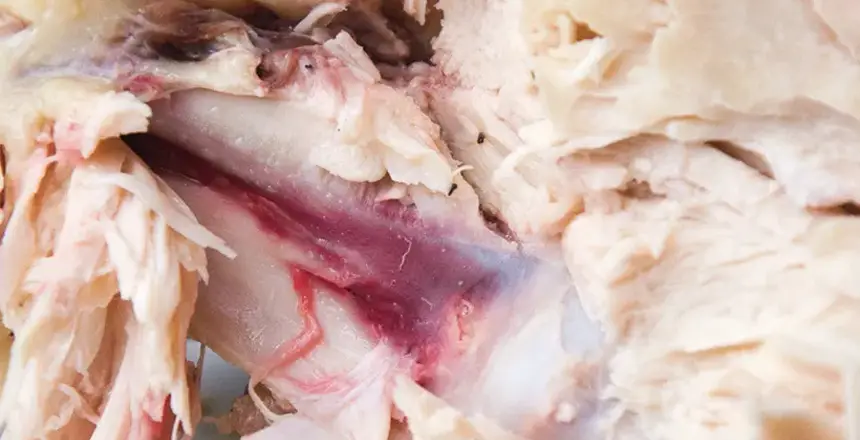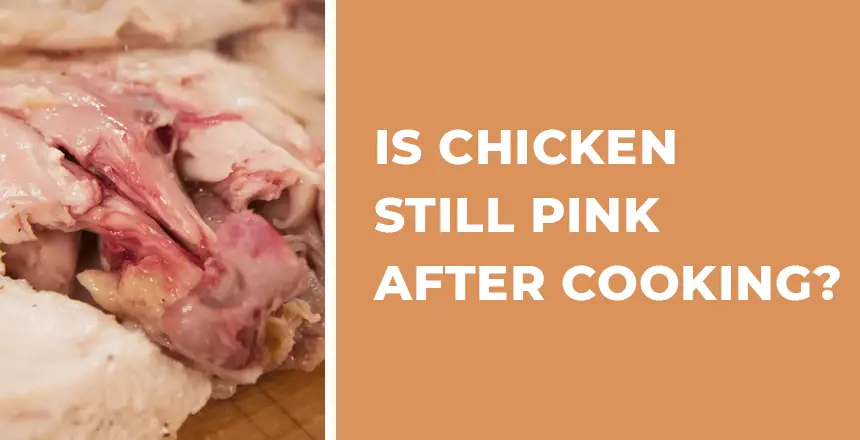Have you ever noticed that chicken is still pink even after cooking? The phenomenon of pink chicken can be puzzling and raise concerns about its safety for consumption. In fact, it is safe to eat chicken as long as it reaches an internal temperature of 165°F (74°C).
Based on our experience, we delve into the topic to provide you with a comprehensive understanding of why chicken can be pink after cooking, the factors influencing its color, and essential tips to ensure you cook the chicken to perfection without compromising safety.
So, let’s unravel the mystery and equip ourselves with the knowledge to enjoy delicious, properly cooked chicken with confidence.
Related:
- How to Tell if Chicken Sausage Is Cooked?
- How Many Chicken Tenderloins Are in 4 Oz?
- How Long is Chicken Good After the Sell-By Date?
- How Long To Fry Chicken Thighs?
- How Long to Boil Chicken Legs?
- How Long to Bake a Whole Chicken at 425F
Why is Raw Chicken Naturally Pink?
Raw chicken is naturally pink due to the presence of a protein called myoglobin. Myoglobin is a pigmented protein found in muscle tissues, including chicken. It serves a vital role in storing and delivering oxygen to the muscles, which is necessary for their proper functioning. The myoglobin molecule contains iron, which gives it a reddish-pink color.
This natural pink color can vary in intensity depending on factors such as the age and breed of the chicken. Younger chickens generally have lighter-colored meat, while older chickens may have darker or more intense shades of pink. The pink color in raw chicken is a natural characteristic and does not necessarily indicate that the meat is undercooked or unsafe to consume.
What Causes Cooked Chicken to Turn Pink?

Cooked chicken can sometimes appear pink due to a phenomenon known as “persistent pink.” This occurrence can be attributed to various factors that can affect the color of the chicken meat.
One of the main reasons is the presence of gases, such as nitric oxide, during the cooking process. These gases can react with the myoglobin protein in the chicken, altering its color and causing it to turn pink even when fully cooked.
It’s important to note that not all instances of pink chicken after cooking are the result of persistent pink. If the chicken has been properly cooked and has reached the recommended internal temperature of 165°F (74°C), the color change is likely due to factors unrelated to doneness.
Persistent pink chicken is not always a cause for concern if the internal temperature has been reached and proper cooking techniques have been followed. However, if the chicken is undercooked and hasn’t reached the appropriate temperature, it is essential to continue cooking until it is fully done to ensure food safety.
What Are Some Factors That Can Influence Chicken’s Color?
Several factors can influence the color of cooked chicken, resulting in variations in its appearance. These factors include:
Age
Younger chickens typically have lighter-colored meat, which can appear pink even when fully cooked. As chickens mature, their muscles develop more myoglobin, resulting in a darker color.
Diet
The diet of the chicken can affect its color. Chickens raised on certain diets that contain high levels of pigments, such as beta-carotene found in certain types of feed, may have a more intense natural color. This can lead to a deeper shade of pink in the cooked meat.
Cooking Method
The cooking method employed can also impact the color of the chicken. For example, grilling or barbecuing chicken can result in the development of a pinkish hue due to exposure to smoke or certain compounds present in the marinade. On the other hand, chicken cooked in a closed environment, such as in a covered pan or oven, may exhibit less color change.
Processing and Storage
The color of chicken can be influenced by specific processing and storage techniques. For instance, commercially processed chicken may undergo treatments that can alter its color, including the addition of brines or other solutions. Additionally, prolonged storage or exposure to air can cause the meat to develop a pinkish color, even when properly cooked.
Is It Safe to Eat Pink Chicken?
While pink chicken can sometimes be safe to eat, it is not always an indicator of doneness or safety. The best way to ensure safety is by checking the internal temperature with a food thermometer.
If the chicken reaches the recommended temperature of 165°F (74°C), it is safe to consume even if it retains a slight pink hue. However, if the chicken remains pink and hasn’t reached the proper temperature, it is important to continue cooking until it does.
What Happens If You Eat Undercooked Chicken?
Consuming undercooked chicken poses health risks due to the potential presence of harmful bacteria such as Salmonella or Campylobacter. These bacteria can cause foodborne illnesses, resulting in symptoms like nausea, diarrhea, abdominal cramps, and fever.
It is important to cook chicken thoroughly to eliminate any potential bacteria and ensure food safety. If you accidentally consume undercooked chicken or suspect it may be undercooked, it is advised to monitor your symptoms and consult a healthcare professional if you experience any signs of illness.

What Are Some Tips For Properly Checking The Temperature and Avoiding Overcooking?
To ensure chicken is cooked thoroughly without overcooking, it is crucial to follow proper temperature-checking techniques. Here are some helpful tips:
Use a Reliable Food Thermometer
Invest in a digital food thermometer to accurately measure the internal temperature of the chicken. This will provide you with the most reliable indicator of doneness. Thermometers with a probe are especially useful as they can be placed into the thickest area of the chicken without coming into contact with the bone.
Insert The Thermometer Correctly
Insert the thermometer into the thickest part of the chicken, avoiding bones. This is important as bones can conduct heat differently and give inaccurate temperature readings. Ensure the thermometer’s probe is inserted deep into the meat for an accurate measurement.
Check The Temperature at Different Spots
To ensure even cooking, check the temperature in multiple spots of the chicken. This is especially important for larger pieces or whole chickens. Take readings in the thickest part of the breast, thigh, and wing to ensure the entire chicken reaches the appropriate temperature.
Follow The Recommended Internal Temperature
According to the guidelines set by the USDA, it is advised to cook chicken until it reaches an internal temperature of 165°F (74°C). to ensure it is safe to eat. At this temperature, any harmful bacteria present in the meat are effectively killed.
Rest The Chicken
After cooking, allow the chicken to rest for a few minutes. This allows the heat to distribute evenly throughout the meat, ensuring it remains moist and tender. During this resting period, the internal temperature of the chicken will continue to rise slightly, so keep that in mind when checking doneness.
FAQs
How Long Should I Cook Chicken to Ensure It’s Fully Cooked?
Cooking time varies, so rely on the internal temperature rather than cooking time. Cook chicken until it reaches 165°F (74°C) for safe consumption.
What Should I Do If My Cooked Chicken Is Still Pink After Reaching The Recommended Temperature?
Continue cooking the chicken until it is no longer pink and reaches the appropriate temperature to ensure any bacteria are thoroughly killed.
Can I Rely On Visual Cues Alone to Determine If Chicken is Fully Cooked?
Visual cues are not always reliable indicators of doneness. For safety, utilize a food thermometer to verify that the chicken reaches a temperature of 165°F (74°C).
Are There Alternatives To Using a Food Thermometer?
While a food thermometer is the most accurate method, alternative signs include clear juices, firmness, and lack of pinkness. However, a food thermometer is recommended for accurate results.
Are There Any Health Risks Associated With Consuming Overcooked Chicken?
Overcooked chicken may become dry and less flavorful, but it is generally safe to eat.
Can Chicken Become Pink Again After Being Refrigerated?
Yes, chicken can develop a pink color again after refrigeration due to various factors. However, as long as it was properly cooked and reached the appropriate internal temperature, it should still be safe to consume.
Final Thoughts
The mystery of pink chicken after cooking has been unraveled. Understanding the science behind pink chicken after cooking and the factors that influence its color empowers you to cook chicken safely and confidently.
Remember, the color of cooked chicken isn’t always a reliable indicator of its doneness or safety. Temperature, measured with a food thermometer, is the key to ensuring that your chicken is thoroughly cooked and free from harmful bacteria.
So next time you encounter pink chicken, you’ll have the knowledge to assess its safety and take appropriate action.


